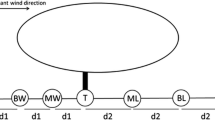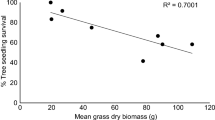Abstract
In semi-arid lands, vegetation is distributed in shrub patches immersed in a less vegetated interpatch matrix. Grazing affects perennial grass seed bank through a decrease in seed rain and an increase in seed predation and soil compaction. Nevertheless, some species with anchorage mechanisms in their seeds might overcome this, such as Nassella tenuis (Phil.) Barkworth. This is an important species in grazing paddocks because it has an intermediate palatability and its relatively tolerant to grazing. These characteristics allow N. tenuis to increase its abundance in grazed sites. Our objective was to assess how grazing affects the key palatable species from seeds to seedlings: i.e., seed rain, soil seed bank, and seedling recruitment in different microsites along a windward-leeward transect across shrub canopy. We hypothesized that: (1) the negative effects of grazing on N. tenuis fructification are reflected in its seed rain, soil seed bank, and seedling recruitment, especially in interpatches; (2) Nassella tenuis seed rain reduction, soil compaction by cattle in grazed sites, and removal of seeds by wind decrease its soil seed bank, especially in microsites exposed to the predominant wind; and (3) the decrease in N. tenuis soil seed bank and cover increase in annual species in grazed sites have negative effects on its seedling recruitment, especially in microsites exposed to predominant wind. We placed seed traps, collected soil samples, and monitored seedling recruitment in different locations around shrub canopy to address our hypotheses. Also, we established a manipulative experiment in which we sow N. tenuis seeds and followed its recruitment in different microsites. We compared the seed rain, soil seed bank, natural seedling recruitment, and sown seeds recruitment of N. tenuis between grazed and ungrazed sites. We analyzed differences between microsites along a windward-leeward transect across shrubs patches. Seed rain and soil seed bank had the same density in patches and interpatches both in ungrazed and grazed sites. But seed rain was higher, and soil seed bank was lower in ungrazed sites than in grazed sites. Almost all under-canopy microsites showed greater soil seed bank abundance and natural seedling recruitment in ungrazed sites. Sown seeds recruitment was the same between grazed and ungrazed sites, but it showed protective effects of shrubs in leeward microsites under grazed sites. As a conclusion, seed rain and soil seed bank are complementary under grazed sites.
Similar content being viewed by others
References
Aerts R, Maes W, November E, et al. 2006. Surface runoff and seed trapping efficiency of shrubs in a regenerating semiarid woodland in northern Ethiopia. CATENA, 65(1): 495–503.
Aguiar M R, Sala O E. 1999. Patch structure, dynamics and implications for the functioning of arid ecosystems. Trends in Ecology and Evolution, 14(7): 495–503.
Allington G R H, Valone T J. 2014. Islands of fertility: A byproduct of Grazing? Ecosystems, 17: 495–503.
Amarilla J, Anton A M R, Bell H, et al. 2017. Poaceae. In: Zuloaga F O, Belgrano M J. Vascular Flora of the Argentinean Republic, vol. 7. Buenos Aires: Estudio Sigma S.R.L., 163–205. (in Spanish)
Anton A M, Zuloaga F O. 2018. Flora Argentina. [2021–08-16]. http://www.floraargentina.edu.ar.
Asner G P, Elmore A J, Olander L P, et al. 2004. Grazing systems, ecosystem responses, and global change. Annual Review of Environment and Resources, 29: 495–503.
Badano E I, Samour-Nieva O R, Flores J, et al. 2016. Facilitation by nurse plants contributes to vegetation recovery in human-disturbed desert ecosystems. Journal of Plant Ecology, 9(5): 495–503.
Beever E, Huso M, Pyke D. 2006. Multiscale responses of soil stability and invasive plants to removal of non-native grazers from an arid conservation reserve. Diversity and Distributions, 12(3): 495–503.
Bertiller M B, Aloia D A. 1997. Seed bank strategies in Patagonian semi-arid grasslands in relation to their management and conservation. Biodiversity and Conservation, 6: 495–503.
Bisigato A J, Bertiller M B. 2004. Seedling recruitment of perennial grasses in degraded areas of the Patagonian Monte. Journal of Range Management, 57(2): 495–503.
Bisigato A J, Villagra P E, Ares J O, et al. 2009. Vegetation heterogeneity in Monte Desert ecosystems: A multi-scale approach linking patterns and processes. Journal of Arid Environment, 73(2): 495–503.
Busso C, Bonvissuto G, Torres Y. 2012. Seedling recruitment and survival of two desert grasses in the Monte of Argentina. Land Degradation and Development, 23(2): 495–503.
Caballero I, Olano J, Escudero A, et al. 2008. Seed bank spatial structure in semi-arid environments: beyond the patch-bare area dichotomy. Plant Ecology, 195: 495–503.
Chambers J C. 2000. Seed movements and seedling fates in disturbed sagebrush steppe ecosystems: implications for restoration. Ecological Applications, 10(5): 495–503.
Cherlet M, Hutchinson C, Reynolds J, et al. 2018. World Atlas of Desertification. Luxembourg: Publication Office of the European Union.
De la Cruz M, Romao R L, Escudero A, et al. 2009. Where do seedlings go? A spatio-temporal analysis of seedling mortality in a semi-arid gypsophyte. Ecography, 31(6): 495–503.
DeFalco L A, Esque T C, Kane J M, et al. 2009. Seed banks in a degraded desert shrubland: Influence of soil surface condition and harvester ant activity on seed abundance. Journal of Arid Environments, 73(10): 495–503.
Di Rienzo J A, Casanoves F, Balzarini M G, et al. 2011. InfoStat version 2011. Córdoba: InfoStat Group, FCA, National University of Córdoba.
Eldridge D J, Poore A G B, Ruiz-Colmenero M, et al. 2016. Ecosystem structure, function, and composition in rangelands are negatively affected by livestock grazing. Ecological Applications, 26(4): 495–503.
Fernández O A, Gil M E, Distel R A. 2009. The challenge of rangeland degradation in a temperate semiarid region of Argentina: the Caldenal. Land Degradation and Development, 20(4): 495–503.
Fuls E R. 1992. Semi-arid and arid rangelands: a resource under siege due to patch-selective grazing. Journal of Arid Environments, 22(2): 495–503.
Funk F A, Peter G, Leder C V, et al. 2018. The impact of livestock grazing on the spatial pattern of vegetation in north-eastern Patagonia, Argentina. Plant Ecology and Diversity, 11(2): 495–503.
Funk F A, Loydi A, Peter G, et al. 2019. Effect of grazing and drought on seed bank in semiarid patchy rangelands of Northern Patagonia, Argentina. International Journal of Plant Sciences, 180(4): 495–503.
Giladi I, Segoli M, Ungar E. 2013. Shrubs and herbaceous seed flow in a semi-arid landscape: dual functioning of shrubs as trap and barrier. Journal of Ecology, 101(1): 495–503.
Godagnone R E, Bran D E. 2009. Integrated Inventory of the Natural Resources of the Río Negro Province: Geology, Hydrogeology, Geomorphology, Soils, Climate, Vegetation and Fauna. Buenos Aires: INTA. (in Spanish)
Hanke W, Böhner J, Dreber N, et al. 2014. The impact of livestock grazing on plant diversity: an analysis across dryland ecosystems and scales in southern Africa. Ecological Applications, 24(5): 495–503.
Kröpfl A I, Deregibus V A, Cecchi G A. 2007. Disturbances in a shrubby steppe of the Monte: changes in vegetation. Ecología Austral, 17: 495–503. (in Spanish)
Kröpfl A I, Villasuso N M. 2012. Recognition Guide of Grassland Species of Oriental Patagonian Monte. Guadalupe Peter (Col.). Bariloche: INTA, 24. (in Spanish)
Leder C V, Peter G, Funk F A. 2015. Seed rain alteration related to fire and grazing history in a semiarid shrubland. Journal of Arid Environments, 121: 495–503.
Leder C V, Peter G, Funk F A, et al. 2017. Consequences of anthropogenic disturbances on soil seed bank diversity and nurse shrub effect in a semiarid rangeland. Biodiversity and Conservation, 26: 495–503.
Leder C V, Torres Robles S S, Peter G. 2021. Moderate disturbances and shrub protection enhance perennial grass recruitment in northern Patagonia. Journal of Arid Environments, 189: 104479, doi: https://doi.org/10.1016/j.jaridenv.2021.104479.
Marone L, Rossi B E, López de Casenave J. 1998. Granivore impact on soil-seed reserves in the central Monte desert, Argentina. Functional Ecology, 12(4): 495–503.
Mayor M D, Bóo R M, Peláez D V, et al. 2003. Seasonal variation of the soil seed bank of grasses in central Argentina as related to grazing and shrub cover. Journal of Arid Environments, 53(4): 495–503.
Milton S J, Wiegand T. 2001. How grazing turns rare seedling recruitment events to non-events in arid environments. In: Breckle S W, Veste M, Wucherer W. Sustainable Land use in Deserts. Berlin: Springer, 197–207.
Moreno de las Heras M, Turnbull L, Wainwright J. 2016. Seed-bank structure and plant-recruitment conditions regulate the dynamics of a grassland-shrubland Chihuahuan ecotone. Ecology, 97(9): 495–503.
O’Connor T G. 1991. Local extinction in perennial grasslands: A life-history approach. The American Naturalist, 137: 495–503.
O’Connor T G, Pickett G. 1992. The influence of grazing on seed production and seed banks of some African savanna grasslands. Journal of Applied Ecology, 29(1): 495–503.
Oyarzabal M, Clavijo J, Oakley L, et al. 2018. Vegetation units of Argentina. Ecología Austral, 28: 495–503. (in Spanish)
Paruelo J M, Pütz S, Weber G, et al. 2008. Long-term dynamics of a semiarid grass steppe under stochastic climate and different grazing regimes: a simulation analysis. Journal of Arid Environments, 72(12): 495–503.
Pazos G E, Bertiller M B. 2007. Spatial patterns of the germinable soil seed bank of coexisting perennial-grass species in grazed shrublands of the Patagonian Monte. Plant Ecology, 198: 495–503.
Peter G, Funk F A, Torres Robles S S. 2013. Responses of vegetation to different land-use histories involving grazing and fire in the north-east Patagonian Monte, Argentina. Rangeland Journal, 35: 495–503.
Peter G, Leder C V, Funk F A. 2016. Effects of biological soil crust and water availability on seedlings of three perennial Patagonian species. Journal of Arid Environments, 125: 495–503.
Pol R G, Sagario M C, Marone L. 2014. Grazing impact on desert plants and soil seed Banks: implications for seed-eating animals. Acta Oecologica, 55: 495–503.
Roig F, Roig-Junent S, Corbalán V. 2009. Biogeography of the Monte desert. Jorunal of Arid Environments, 73(2): 495–503.
Sanou L, Zida D, Savadogo P, et al. 2018. Comparison of aboveground vegetation and soil seed bank composition at sites of different grazing intensity around a savanna-woodland watering point in West Africa. Journal of Plant Research, 131: 495–503.
Siffredi G L, Boggio F, Giorgetti H, et al. 2015. Grasslands Evaluation Guide: for Western Mountain Ranges and Plateaus, and Northern Patagonian Monte Ecological Areas. Bariloche: INTA, 27–47. (in Spanish)
Tuesca D, Nisensohn L, Boccanelli S, et al. 2004. Weed seed bank and vegetation dynamics in summer crops under two contrasting tillage regimes. Community Ecology, 5: 495–503.
Val J, Travers S K, Oliver I, et al. 2020. Perennial plant patches are sinks for seeds in semi-arid woodlands in varying condition. Applied Vegetation Science, 23(3): 495–503.
Vázquez D P, Simberloff D. 2004. Indirect effects of an introduced ungulate on pollination and plant reproduction. Ecological Monographs, 74(2): 495–503.
Whitford W. 2002. Wind and water process. In: Whitford W. Ecology of Desert Systems. London: Academic Press, 65–97.
Wilby A, Shachak M. 2000. Harvester ant response to spatial and temporal heterogeneity in seed availability: pattern in the process of granivory. Oecologia, 125(4): 495–503.
Acknowledgements
This work was supported by the National University of Río Negro (PI 40-C-654, PI 40-C-873). This work was part of Dr. Cintia LEDER and Dr. Lic Dianela CALVO fellowships provided by the National Scientific and Technical Research Council (CONICET). We also like to thank Mr. Omar GRIFFITHS, Mr. Antonio BARROSO, Mr. Martín MORÁN and Mr. Sebastián MORÓN for allowing us to carry out our field research on their lands.
Author information
Authors and Affiliations
Corresponding author
Rights and permissions
About this article
Cite this article
Leder, C.V., Calvo, D.A. & Peter, G. Seed rain and soil seed bank compensatory roles on Nassella tenuis (Phil.) Barkworth seedling recruitment in ungrazed and grazed sites. J. Arid Land 14, 550–560 (2022). https://doi.org/10.1007/s40333-022-0015-y
Received:
Revised:
Accepted:
Published:
Issue Date:
DOI: https://doi.org/10.1007/s40333-022-0015-y




